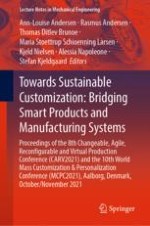2022 | Book
Towards Sustainable Customization: Bridging Smart Products and Manufacturing Systems
Proceedings of the 8th Changeable, Agile, Reconfigurable and Virtual Production Conference (CARV2021) and the 10th World Mass Customization & Personalization Conference (MCPC2021), Aalborg, Denmark, October/November 2021
Editors: Assist. Prof. Ann-Louise Andersen, Dr. Rasmus Andersen, Assoc. Prof. Thomas Ditlev Brunoe, Dr. Maria Stoettrup Schioenning Larsen, Assoc. Prof. Kjeld Nielsen, Dr. Alessia Napoleone, Dr. Stefan Kjeldgaard
Publisher: Springer International Publishing
Book Series : Lecture Notes in Mechanical Engineering
